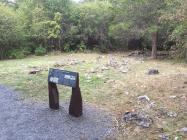Mount Independence State Historic Site
"ordered a large Stoer House to be built." -Col. Jeduthan Baldwin, August 17, 1776
At least one of the storehouses constructed on Mount Independence during the Revolution stood in this area. Portions of the remaining stone foundations are discernable to the left, although the many outcroppings of bedrock and ledges make it difficult to distinguish between natural and man-made formations.
The success of large defensive outposts such as Mount Independence, located miles from any settlement, depended on the secure storage and re-supply of materials needed for a garrison: tools of all kinds, building supplies, armaments, ammunition, powder, tents, food, clothing, and medicine. The Commissary and Quartermaster departments of the Continental Army managed the ordering, inventory, and distribution of supplies to each regiment throughout the country.
In August 1776 Chief Engineer Jeduthan Baldwin ordered a party of carpenters, who came from many regiments and were under the leadership of Lt. Benjamin Beal of the 25th Continental Regiment (Massachusetts), to start constructing two storehouses. Supplies to be stored in this building had been shipped in from Albany, New York, and then probably were hauled here over a road from the wharf at the southern end of the Mount, a distance of over a quarter mile. This was an advantageous location, between the encampments of the Second and Third Brigades.
Beal recorded in his journal on August 15, "raised the store for the army 96 feet in length & had orders to build one 60 feet by 30." Both structures were timber-framed, with no windows, and had wooden floors. There was probably a room for the commissary for food or the quartermaster for all other supplies. Not enough of this foundation remains to determine if it was the larger or smaller storehouse.
These large buildings were used for other purposes if there was a need. When the 18th Continental Regiment (Massachusetts) arrived on Mount Independence in late August 1776, it possessed no tents. Until the men could build proper housing, they were ordered to quarter in this newly completed and still empty storehouse. Food-related remains such as butchered animal bones and bottle fragments, discovered outside the walls in a 1992 archeological study, are evidence of the time this building served as housing. Other items outside the walls included buttons, gunflints, nails, and spikes, and may relate to either the use of this building for housing or for storage.
Respect our history. Take only photographs.
| HM Number | HMCQK |
|---|---|
| Tags | |
| Placed By | Mount Independence State Historic Site |
| Marker Condition |           8 out of 10 (1 reports) |
| Date Added | Friday, September 5th, 2014 at 5:15pm PDT -07:00 |
| UTM (WGS84 Datum) | 18T E 630305 N 4853582 |
|---|---|
| Decimal Degrees | 43.82383333, -73.37951667 |
| Degrees and Decimal Minutes | N 43° 49.43', W 73° 22.771' |
| Degrees, Minutes and Seconds | 43° 49' 25.80" N, 73° 22' 46.26" W |
| Driving Directions | Google Maps |
| Area Code(s) | 802 |
| Closest Postal Address | At or near 28 Shoales Dr, Orwell VT 05760, US |
| Alternative Maps | Google Maps, MapQuest, Bing Maps, Yahoo Maps, MSR Maps, OpenCycleMap, MyTopo Maps, OpenStreetMap |
Is this marker missing? Are the coordinates wrong? Do you have additional information that you would like to share with us? If so, check in.
I Saw The Marker
My ancestor Jonathan Byram and three of his brothers were with the 18th Continental regiment and likely stayed at this location when they arrived at Mount Independence in 1776.
Sep 13, 2015 at 4:22am PDT by kbyram1105
- Is this marker part of a series?
- What historical period does the marker represent?
- What historical place does the marker represent?
- What type of marker is it?
- What class is the marker?
- What style is the marker?
- Does the marker have a number?
- What year was the marker erected?
- This marker could use another picture or two.
- Can this marker be seen from the road?
- Is the marker in the median?

Comments 0 comments